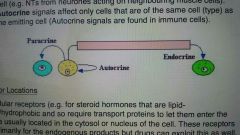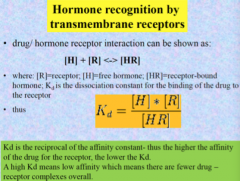![]()
![]()
![]()
Use LEFT and RIGHT arrow keys to navigate between flashcards;
Use UP and DOWN arrow keys to flip the card;
H to show hint;
A reads text to speech;
6 Cards in this Set
- Front
- Back
|
Define the 3 types of signalling molecules (Lecture 2) |

Endocrine - travel through blood to all parts of the body Paracrine - signals target only cells in the vicinity of the emitting cell Autocrine - signals affect only cells that are of the same type as the emitting cell |
|
|
What do allosteric agonists do? |
Allosteric agonists enhance the signal by binding to receptors' allosteric sites of that are involved in signal transmission. |
|
|
What is the strength/magnitude of the signal relayed by a receptor dependent on? (Lecture 2) |

1. The affinityof the hormone for the receptor 2. Theconcentration of the hormone 3. Theconcentration of the receptor |
|
|
What are the 4 main classes of receptors? |
1. Ligand-Gated Ion Channels 2. G-Protein Coupled Receptors/transmembrane/metabotrophic 3. Tyrosine Kinase-Linked Receptors 4. Ligand-Activated Transcription Factors (nuclear) |
|
|
What are the 6 steps of hormone-initiated signal transduction? (Lecture 2) |
1. Biosynthesis of a hormone 2. Storage and secretion of the hormone 3. Transport of the hormone to the target cell 4.Recognition by the hormone receptor protein 5. Relay and amplification of the signal that leads to defined biochemical reactions within the target cell 6. Removal of the hormone. |
|
|
What are the 3 most common intracellular second messenger signalling molecules? (Lecture 3) |
1. Cyclic nucleotides such as cyclic AMP (cAMP) or cyclic GMP (cGMP) 2. Calcium ions 3. Derivatives of the phospholipid, Phosphatidylinositoltriphosphate (PIP3): Inositol-triphosphate (IP3) and diacylglycerol (DAG) |

